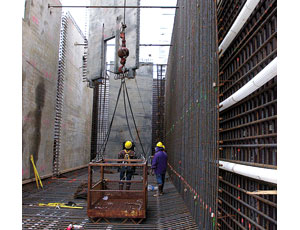Washington Dept. of Transportation officials hope to finalize designs this summer for a 2.3-mi section of the $4.65-billion, 12.8-mi state Route 520 corridor improvement project, in Seattle, which includes the world�s longest floating pontoon bridge.

WsDOT is working with the City of Seattle, the University of Washington, King County Metro and Sound Transit on design decisions regarding the westside section of the corridor. That section includes the planned expansion of an interchange from Route 520 north to the university, a link to the school’s light-rail station and to Interstate 5, and alignment of a future light-rail line, says WsDOT program director Julie Meredith. “I think the last big question we have is, how does the 520 Seattle-side interchange connect [to I-5], and how does the new light-rail station connect?” Meredith says.
The project aims to ease congestion and improve safety on the connector between Seattle and points east. Its centerpiece, a reconstructed, 1.44-mi-long floating bridge over Lake Washington, will have two lanes in each direction and two carpool lanes, plus a 14-ft pedestrian walkway and room for future light rail.
A joint venture of Omaha-based Kiewit Construction Co. and Poulsbo, Wash.-based subsidiary General Contracting Co. Venture won the first $367.3-million contract last year, bidding $180 million below engineers’ estimates.
Kiewit is building a fabrication site in Grays Harbor County, Wash. Starting next year, crews will begin building 21 uniform, 11,000-ton longitudinal pontoons, each 360 ft long, 75 ft wide and 28 ft deep. Ten flanking pontoons will be built to accommodate future expansion as well as two heavier “cross” pontoons to support the transitional spans at either end of the bridge.
Another contract, estimated at roughly $1.4 billion, will go out to bid later this year. It will entail fabricating 44 smaller pontoons and building a new roadway. The road surface of the current bridge, opened in 1963 and carrying 115,000 vehicles daily, lies directly on the pontoons. Since waves wash across the roadway, cracks in the pontoons form quickly.
A new concrete roadway will be elevated above the pontoons by steel trusses, says Larry Kyle, program engineering manager. That strategy will also allow traffic to keep flowing during future pontoon maintenance work.
WsDot recently secured funding for the eastside contracts for a 2014 completion, says Mike Cotton, the project’s design-build director. The $300-million to $500-million portion is on track for a construction start in early 2011, with bids to go out later this year. The 8.8-mi stretch from the bridge to I-405 includes four interchanges, improvements to fish passages and noise walls, says Cotton, as well as two parallel, 660-ft east-approach bridges and two 190-ft steel transition spans next to the floating bridge.
While final design decisions have yet to be made on the westside project, the cost is estimated at $2 billion. That project will include a new half-mile Portage Bay Bridge. The existing 90-ft precast girder bridge sits on hollow precast pilings driven through soft soils.
“Because of the foundation situation, it is subject to failure in the seismic area we are in,” Kyle says. The new six-lane bridge is in the conceptual design phase.



Post a comment to this article
Report Abusive Comment